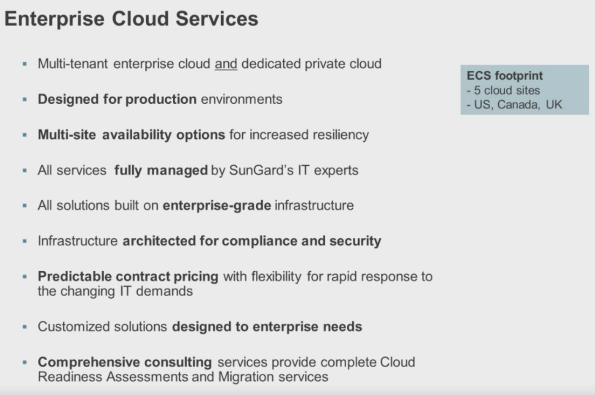SunGard & the High-Availability Cloud
This is 2012, and companies of all sorts, from the smallest single-employee operation to mighty Wal-Mart have begun a relentless march towards the cloud.
Everyone.
I have been on a quest to learn everything about the cloud that I can, not just for personal edification, but also to see how we can deliver appropriate services to our clients based on each company’s specific needs.
As usual, the Microsoft and HP cloud offerings have been my first ports of call.
However, as with any nascent development, it behooves all charged with setting strategy and direction to look at everything out there.
As a result, when I was offered the opportunity to speak with a couple of folks from SunGard Availability Services a short while ago, I accepted.
Why?
SunGard is well known, and very well regarded as a business recovery and continuity company.
For years, a large percentage of Fortune 5000 companies have relied on SunGard to help them secure their backups, retrieve those same backups, and help their businesses recover from disasters, financial or otherwise. By all indications, it has delivered on the promises made.
As a result, SunGard, in my opinion, provides what is the cloud equivalent of mission-critical: a high-availability cloud. This is of a higher order than that generally offered by regular cloud providers.
Let us dive in
Who and what is SunGard?
As explained earlier, SunGard has provided disaster recovery services for enterprises and regulated entities for about three decades of experience, combined with QoSs backed by iron-clad service-level agreements.
For cloud services, SunGard is hoping to replicate their forte with a potent combo of consulting, powerful cloud infrastructure platforms, managed services, and managed applications.
Informationally, SunGard’s verticals are healthcare, retail, manufacturing, financial, and education. They target a swath of companies with annual revenues from $50 million to $2 billion.
The SunGard Cloud
For the cloud, SunGard has transferred its DR and consulting chops into delivering the services in the graphic below.
SunGard
According to SunGard, it takes more than just hosting to deliver its services.
It is involved with client companies from the architecting stage in order to ensure that the client’s goals can be aligned with the services SunGard can deliver.
Once there is an alignment, SunGard moves to managed services mode for the client, I am told. It hosts and manages enterprise apps such as Oracle, SAP, Exchange, databases, and more. SunGard then provides operating system management, backups, and monitoring.
According to SunGard, they are able to provide clients with enterprise basic, private, and multi-tenant platforms within high-security and regulations-compliant datacenters.
For hardware, SunGard relies on the vBlocks from VCE, which is a joint venture of VMware, Cisco Systems, and EMC.
In the vBlock, VMware provides the hypervisor, Cisco provides the server and networking hardware, and EMC provides the storage subsystems.
On paper, this is a formidable product.
However, I am not convinced at just one of the planks on this platform: the server component. I believe that the server subsystem is the weak link here, and the most unproven of this solution. Nevertheless, that weakness can be managed, and actually turned into an asset by a savvy operator, and datacenter manager.
Which SunGard is.
As explained in the sidebar above, if expertly managed, the shortcomings I see in the vBlock product can be turned into an asset, and it appears that SunGard has succeeded in leveraging years in DR to bring just that.
I hope to follow up on SunGard to learn more about their offerings, and to see if there is something in their plans for a Windows-centric constituency such as mine.
Conclusions
SunGard is something I hadn’t thought about when I commenced on my “Cloud Journey” several months ago.
Rather than either just hosting, a la Rackspace, or IaaS or PaaS plays such as Windows Azure or Amazon Web Services, SunGard brings managed cloud services and disaster recovery/bulletproof web-based business continuity to the midmarket with plans to drive that downwards.
While I am not totally convinced in the adequacy of both their hardware platform choice in the VCE vBlock product, and the current strict and monolithic requirement to move prospects to the VMware platform instead of letting them BYOHypervisor, I think they are doing their clients a service by sticking to their core competencies. That, after all, is what we do at Logikworx.
SunGard’s chances look good. They have a well-established, and equally well-respected brand in business continuity, and they are relying on proven hardware from Tier-1 OEMs in the VCE vBlock.

